| Reviews & Columns |
|
Reviews DVD TV on DVD Blu-ray 4K UHD International DVDs In Theaters Reviews by Studio Video Games Features Collector Series DVDs Easter Egg Database Interviews DVD Talk Radio Feature Articles Columns Anime Talk DVD Savant Horror DVDs The M.O.D. Squad Art House HD Talk Silent DVD
|
DVD Talk Forum |
|
|
| Resources |
|
DVD Price Search Customer Service #'s RCE Info Links |
|
Columns
|
|
|
Space Pirate Captain Herlock: The Endless Odyssey: The Complete Series
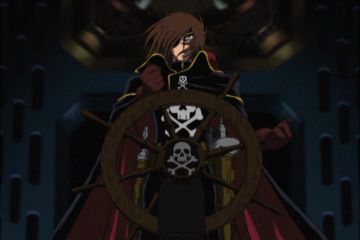
This is Captain Herlock at the wheel.
Series: Space Pirate Captain Herlock: The Endless Odyssey is the 2002 series released in Japan as directed by Taro Rin and written by creator Leiji Matsomoto. It is set in the far future when Earth is no longer plagued by the dominating Machine Men or other invaders that had taken control of the planet, only to be beaten back by the crew of the Arcadia and Captain Herlock. In fact, it is set at a point in time when the need for independent operators like Herlock is seemingly long past, with the Captain missing for a long time as the remainder of his crew, including Kei as pictured below, are finally captured by the Space Sheriffs. The peace of the various human outposts aside, no threats have appeared in years and the universe is prospering like never before. That brings us to the point where the real story begins, with a strange ship attacking Earth, causing it to disappear.
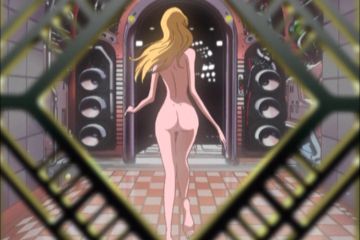
While women aren't typically allowed on Pirate vessels, the Captain wisely made an exception here.
As the self appointed protector of the planet, this wakens Captain Herlock from his drunken slumber and he seeks out his crew in order to restore his beloved planet to its rightful state. Needless to say, the authorities aren't keen on this idea, setting a trap in which to capture him once and for all. They are unaware of the imminent threat to all of mankind by a dangerous creature locked away long ago that uses a primordial fear that all humans seem to possess as a means to destroy them. As its four henchmen go about wreaking havoc, they soon find that they overlooked a single man that possesses no such fear but underestimate his abilities and determination as meaningless compared to their power.
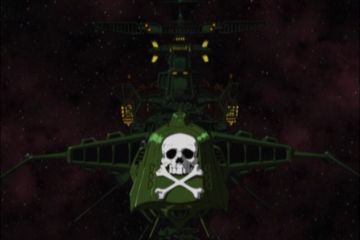
If this is the space ship on your screen, you'd better hope to be a friend.
As all good fans know, this miscalculation on their part leads to some heated space battles and rather crude attempts by the aliens (called the Noo) to turn Herlock and his crew against one another as they did with the authorities. By the time they understand his resolve, they are fighting him on his terms and that was where the pedal hit the metal in terms of the show taking off at warp speed for this reviewer. The back of the DVD covers said this about the individual volumes of the show:
"Tadashi enjoyed living like a punk on the Planet of the Rubbish Heap, but then he came home to find his father dead and four possessed corpses standing over his body. As they attack Tadashi, the fearless Captain Herlock, the last Space Pirate, saves Tadashi's life and says "If you want to become a real man, board my ship." Seizing the opportunity to avenge his father, Tadashi joins the crew of the space battleship Arcadia as it pursues their mysterious enemy in an attempt to rescue the promised land- Earth!! The vast fleet of the Space Sheriff Station attacks the Fata Morgana, the research ship of the space archeological team that perished five years ago that now contains the Noo. However, just as the Solar System fleet before them, the Noo turn the fear of the fleet's ships against each other and the Space Sheriff ships slaughter each other! Only the Arcadia remains to prevent the Noo from escaping, but can Captain Herlock and his crew hold off against their fear and the injured commander of the Space Sheriffs who is still determined to eliminate the Arcadia?!
The Noo captures Tadashi and Maji, the engineer for the Arcadia, and forces them to fight a huge monster in hopes of luring Herlock to rescue them. While that part of the plan is successful, the spiritual battle leads to Herlock's victory and the Noo defeated! Unfortunately, the victory is short lived for the Noo possesses Kei's unconscious body and begins using her to sabotage the Arcadia. Tadashi, feeling guilty for putting Kei in this situation, tempts the Noo with his own body and engages the Noo in a spiritual battle to save Kei and the Arcadia- will he have the willpower to defeat the Noo?! Upon reaching Neo-Terra, Yattaran's invention disables the Fata Morgana's revitalization abilities, but then the planet itself attacks the Arcadia! After the ship barely survives the first attacks, Herlock forces the crew off of the ship and pursues the Noo by himself. Will Herlock be able to prevent a dark future for everyone, or will terrible secrets be revealed?!"
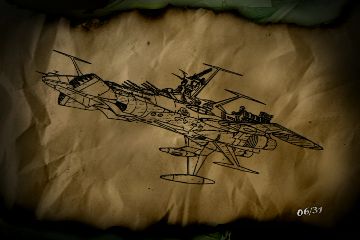
The design of this ship always impresses me as looking ultra cool.
While I know this all seems indicative of previous exploits by the good Captain, the nuances worked in were a reminder of the quality that went into the show. I know my pal John wasn't too keen on the picture quality (and he was right about it looking soft, dark, and poorly mastered, I chalked it up to an artistic attempt at making the series look like it fit closer in time to the original (or perhaps follow up) series that the Captain starred in back in the late 1970's to early 1980's. Still, as a Harlock fan from way back, I'll admit that my appreciation for his exploits surpass that of those who prefer some of the newer kinds of animation that John and I find hit or miss all too often. Here's a list of the episodes for those wanting one:
1) Blues of the Rubbish Heap
2) For Whom The Friend Sleeps
3) The Voice Calling For Noo From Afar
4) Yattaran's 30-Second Bet
5) Battlefield – The Tombstone Planet
6) A Gentle Smile on the Skull of Memory
7) The Moon Waits in the Promised Land
8) Somewhere in the Decimated Planet Lies the Castle Ruins
9) In the Depths of the Shadows of the Soul
10) Kei - Illusion
11) Trembling Universe
12) The Soul Drifts to the Far Ends, with No Words at Parting
13) …The End
They don't make them like this very often and I mean that in a bad way since I found the series to be engaging, entertaining, and full of the kind of writing that has made creator Leiji Matsomoto a cultural legend in Japan and elsewhere. I wish all of the series dedicated to the space pirate were available on DVD, preferably cleaned up with newly mastered audio to enhance the experience but the basic story that Harlock lives is that of a universal champion that does the right thing rather than the popular thing, showing his principles to the bigger elements of life to serve him well. The extras were plentiful and aside from some of the audio and video issues that have been reported online, I can safely say that Space Pirate Captain Herlock: The Endless Odyssey: Complete Series is a keeper that fans of exciting adventures will enjoy repeatedly to the point that a rating of Highly Recommended is fair.
Picture: Space Pirate Captain Herlock: The Endless Odyssey was presented in the same 1.33:1 ratio full frame color it was shot in by director Taro Rin. I thought the picture was especially soft in certain areas but at times I wasn't sure if this was done on purpose as an artistic attempt to make it look more like some of the older Harlock adventures or if it was simply due to a bad transfer. I opted to believe it was deliberately done and while the picture was not crisp and clear, the blacks weren't true black (I tried to recalibrate my set to compensate), and the other minor issues that arose were indicative of a mixed budget release; the story seemed to look like I expected it would and as a fan of Harlock from his Manga days, that speaks volumes. Yes, I'd like to see another series that cleaned things up a bit and made the show look good compared to contemporary shows but the old school feel was nice too. As a side note, the two part interview with director taro Rin looked absolutely terrible, as though it were shot in the waning days of Krypton under a red sun about to explode (apologies to the lovers of Smallville but that was the best way to describe the incredibly red looking tint on the poorly lit interview).
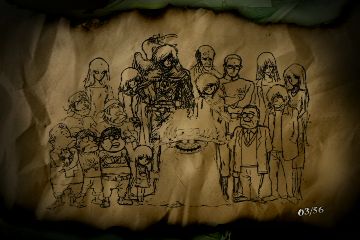
This was the sketch of the crew. Notice who they are all looking at in the suit and tie.
Sound: Space Pirate Captain Herlock: The Endless Odyssey was presented with a choice of 5.1 Dolby Digital Surround in either the original Japanese or the newer English language dub. This was another area of contention I recall coming up in fan forums that has probably caused some to wait for a remastering but my experience was that it wasn't a bad audio experience. Granted, to hear some speak of it, you'd think it was awesome (and that was far from true) but the separation of the tracks provided some serious directionality, and the dynamic range surpassed the visual elements time and again as having a lot of depth and texture. In a few episodes, it sounded like the original track had some misplaced elements (to the point where I wondered aloud to a couple of friends if they had been messing around with my remote control) but the vocal acting was fine on both versions. The special effects were well handled too and the music was such that I wish an isolated score was added to the extras section of the series.
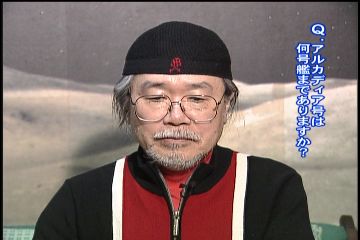
Leiji Matsomoto is one of the founding fathers of anime as far as I'm concerned.
Extras: While the first three volumes of the series sported weak extras, the final volume of the boxed set had a whole extra disc full of material for the fans. There were two multi-angled story boards for the show (the opening episode and the closing one) that provided a lot of information about the evolution of the episodes; using rough sketches and two sets of vocal actors (each had a Japanese volume and a corresponding English version). They lasted as long as the actual episodes and served to showcase some of the ideas that went into the final efforts. This was followed by a lengthy interview with series director Taro Rin (recorded rather poorly in August of 2003). He rambled a bit and I would never have mistaken him for an anime director but the comments made in the subtitled feature proved to show his creativity was alive and well when this was made. That was followed by another lengthy interview, this time with creator Leiji Matsumoto himself, proving to be handled much more professionally as he took the character of Harlock from his high school days where he invented him all the way through to present day Japan. His interview didn't really provide anything substantially new about the character but it was better than reading similar interviews in fanzine type periodicals. There were then four lengthy art galleries offered up; a character guide, a background guide, an Arcadia gallery, and a background artwork piece, totaling hundreds of pictures for fans to appreciate. There were then four separate trailers to the show, a few minutes of CGI clips, some textless openings and closings on the individual discs, paper inserts in the four cases, and four plastic pencil box sheets along with the box itself used to contain the four volumes of the show.
Final Thoughts: Space Pirate Captain Herlock: The Endless Odyssey was an instant winner for me since it had all the action, the deadpan humor of the fearless Captain, and the crew interactions as they assisted him in ridding the world of another menace. The plot points revolving around Tadashi seemed a bit tacked on at times (he was clearly shown to look like a younger version of the Captain, as though he was related to the man) but the wealth of extras, the overall story elements, and the ability to remind me of my affection for the pirate and his adventures was enough to overlook minor issues that came with the technical presentation of the material. In short, Space Pirate Captain Herlock: The Endless Odyssey: The Complete Series was the type of no holds barred action story that you don't see much of anymore; one that combines thoughtful dialogue with meaningful action.
If you enjoy anime, take a look at some of the recommendations by DVD Talk's twisted cast of reviewers in their Best Of Anime 2003, Best Of Anime 2004, and Best of Anime 2005 articles or their regular column Anime Talk.
|
| Popular Reviews |
| Sponsored Links |
|
|
| Sponsored Links |
|
|
| Release List | Reviews | Shop | Newsletter | Forum | DVD Giveaways | Blu-Ray | Advertise |
|
Copyright 2024 DVDTalk.com All Rights Reserved. Legal Info, Privacy Policy, Terms of Use,
Manage Preferences,
Your Privacy Choices | |||||||













